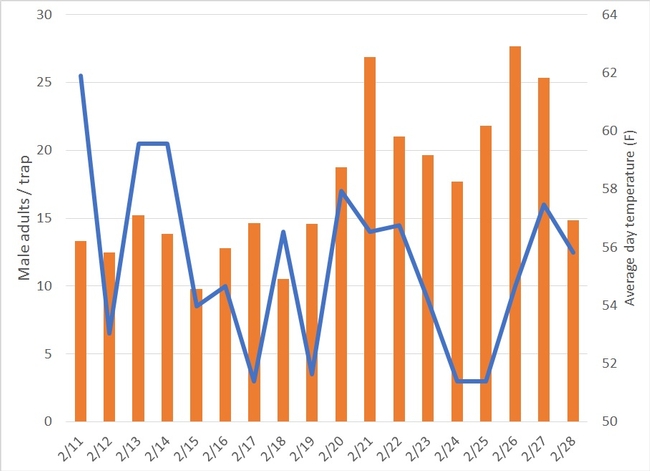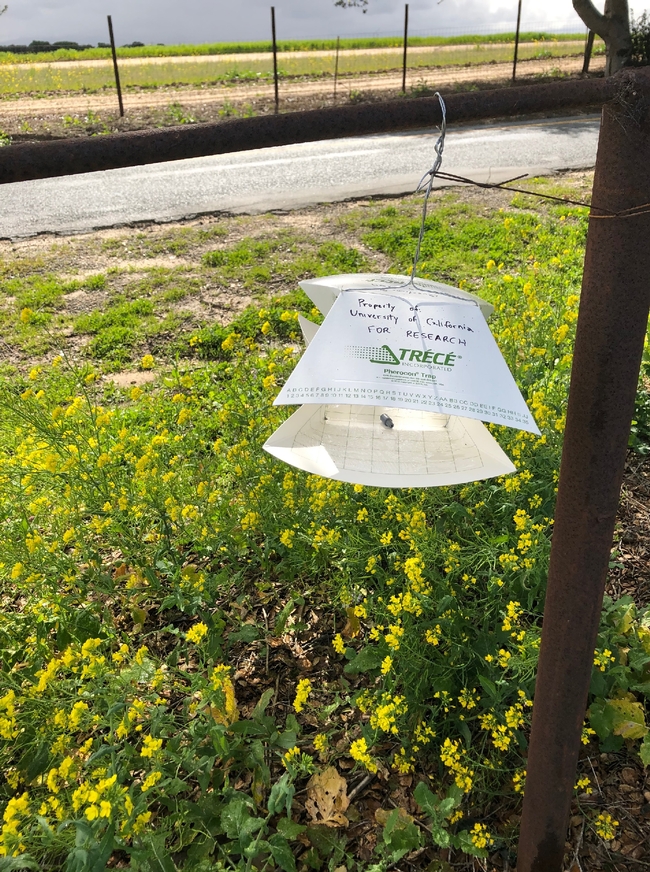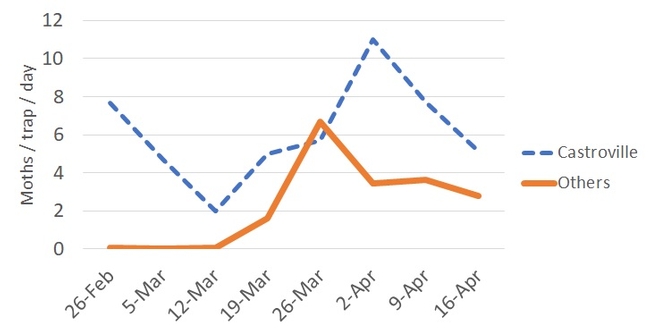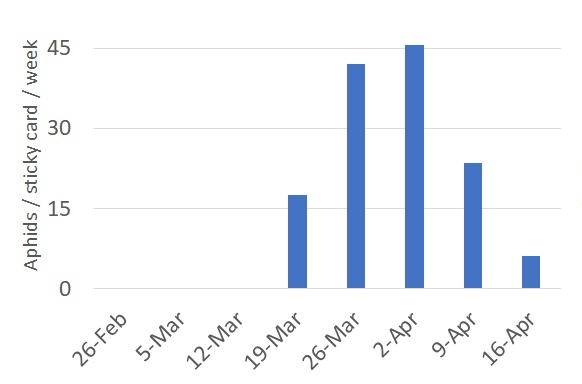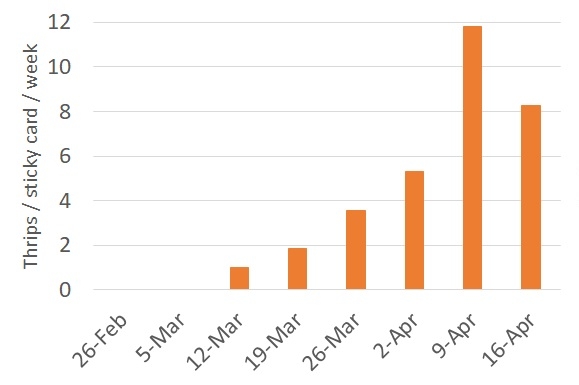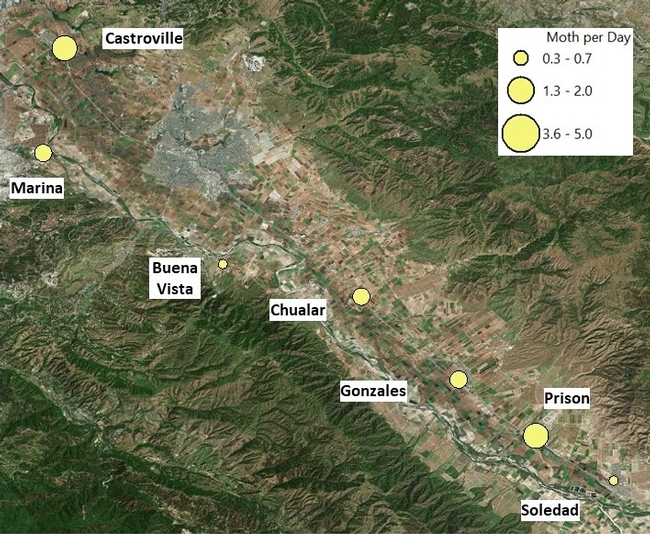- Author: Alejandro Del Pozo-Valdivia
Diamondback moth adults have been actively flying across the Salinas Valley these winter months, based on our area-wide monitoring program. There were a couple of locations where we recorded 'zero' captures during January. It looks like low temperatures in the Valley just slowed down this moth development. At this point, it will be difficult to propose that there was an overwintering generation this past winter. Specially in the Castroville area, where there has never been a 'zero' capture from our two traps. Having an overwintering generation would have represented 'zero' captures from all or most of our pheromone traps across the Valley.
We continue the effort to validate automated pheromone traps. In partnership with AgCeleration and TrapView, we are testing in the field a new prototype (Fig. 1). So far, there is no significant difference on the weekly captures between this new automated trap when compared to a typical cardboard pheromone trap. These automated traps provide real-time information on the number of diamondback moth males captured in a daily based. This type of information could ultimately help to understand the trends of the adults moving across the farmscape, strengthening an IPM program in cole crops.
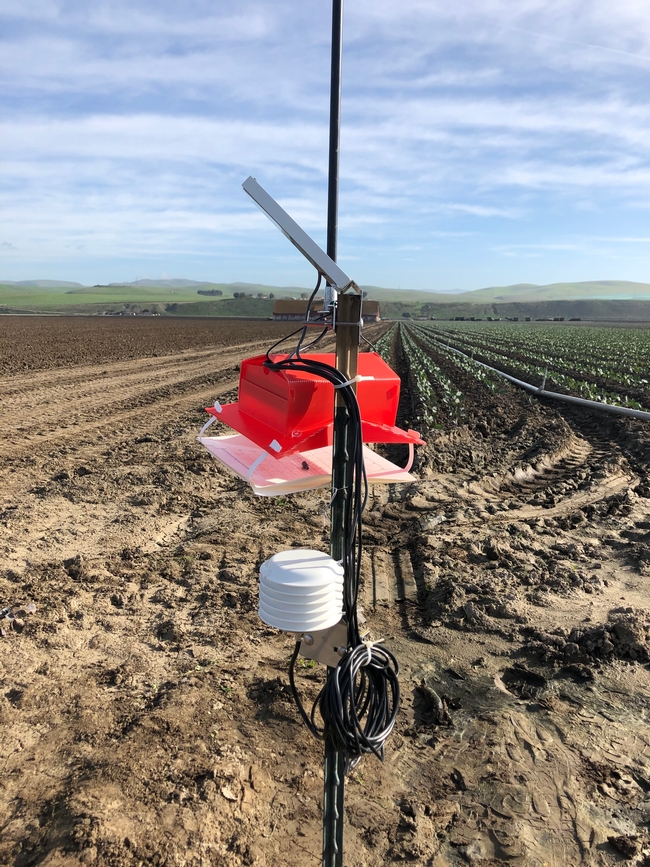
Daily captures of diamondback moth male adults indicate that the highest populations are currently located in the Castroville area. On average, we have captured 12 males per day since February 11th (Fig. 2.). Most of the fluctuation on number of captured adults might have been mediated by air temperatures. The current trend shows that adult captures are going down. It is likely that large populations of this pest were able to go through a generation in the Castroville area using crop, weed host plants, and crop residues. It is important to recognize that:
1) Castroville area continues to be a hot spot with the largest diamondback moth population across the Salinas Valley.
2) Promptly scouting of blocks with cole crops will help to early detect the presence of economically relevant numbers of caterpillars.
3) Manage weeds, specially at the surrounding areas of established blocks, will reduce the overall population.
4) Promptly elimination of cole crop residues from previous plantings will reduce the overall population.
5) Rotate the use of insecticides will reduce the possibility to develop insecticide resistance.
6) Use of adjuvants/stickers will reduce the possibility of washing away any insecticide spray onto waxy cole crop leaves.
If you would like to learn more about the current status of diamondback moth in the Salinas Valley, please contact Alejandro Del-Pozo at adelpozo@ucanr.edu or call 831-759-7359.
- Author: Alejandro Del Pozo-Valdivia
We continue the effort of monitoring diamondback moth (DBM) across the Salinas Valley using sex pheromone baited traps, as shown in the picture above. We have been adding additional traps to cover a larger area along Highway 101. We have daily moth capture data from Castroville to Greenfield. The chart below summarizes these daily captures from our pheromone traps.
As stated in a previous blog post, higher numbers of DBM have been usually recorded in Castroville. It seems like we just passed a generation of adults during late March to early April. Currently, DBM capture numbers are going down. Lower adults in the system could be paired with more caterpillars feeding on several host plants.
We have set up yellow sticky cards to track the overall population of winged aphids and thrips. These sticky cards are in the same locations as the pheromone traps. At this point, data for aphids and thrips is not broken down at the species level.
From the chart above, there was a flight of aphids during late March to early April. Some PCAs mentioned to me that foxglove aphid started to show up in their fields during that time period. It seems now that winged aphid numbers are going down. However, it does not mean that numbers of aphids in our crops are decreasing. We might be facing higher population of wingless aphids in our crops right now.
We need to keep an eye on population dynamics of thrips in the Valley. The ultimate goal is to be better prepared this season to manage those creatures and reduce the incidence of INSV virus. The chart below shows captures of thrips in our sticky cards.
It seems like thrips populations had a spike two weeks ago. Currently, thrips numbers are going down. I believe that keeping track of the fluctuation of thrips numbers in our Valley would help us detect large populations of this pest. There is a need to alert PCAs when the front of a 'thrips wave' would happen.
If you are interested in getting more information on this monitoring effort, please do not hesitate in contacting Alejandro Del-Pozo at 831-759-7359 or adelpozo@ucanr.edu.
- Author: Alejandro Del Pozo-Valdivia
There are sex pheromone traps for Diamondback moth set up across the Salinas Valley. This pheromone only attracts males of this pest. These traps were first put out on February 20th, 2019. Traps are located in Castroville, Marina, Buena Vista, Chualar, Gonzales, by the Prison (near Soledad), and Soledad. Thanks to the PCAs who are helping me with this project.
Basically, numbers of moths per day per trap have been zeros, with the exception of the trap located in Castroville. Interestingly, moths were captured in all traps last week. The actual values of those captures are presented in the below figure as yellow dots. The bigger the dot represents a larger moth capture.
It seems like a new flight for the diamondback moth is about to begin across the Salinas Valley. Additionally, there has not been a break on the life cycle of this pest in the Castroville area. Population of this moth are persistent throughout the year in that area. The trap in Castroville has always captured moths since it was set up. Populations of this moth are residents of brassica weeds, as noted in previous scouting trips.
But, what does it mean to have less than one moth per trap per day, compared to 5 moths per trap per day? Is 5 moths a high value? How is that translated to caterpillars in the field? The next step will be to pair moth trap captures with actual scout data for caterpillars found in the surrounding areas of the traps. In the meantime, the information from these traps could help us to potentially predict when caterpillars might be present in the system in larger numbers. It is more likely that we will be able to see an increase of diamondback moth caterpillars in the next two weeks. It may be good to pay attention to cole crop fields, with the goal to early detect potential damaging populations of this pest in scouted fields.
I will be updating this map with moth captures at least every other week. Stay tune!
If you would like to learn more about this project, do not hesitate in contacting Alejandro Del-Pozo at adelpozo@ucanr.edu or 831-759-7359.
- Author: Jain Long Bi
- Author: Surendra Dara
- Author: Mark Bolda
- Author: Frank Zalom
Lygus bugs (Lygus species) damage strawberry fruit by puncturing individual seeds. This, in turn, stops development of the berry in the area surrounding the feeding site causing fruit distortion called “cat-facing”. Even at moderate densities, Lygus bugs cause economic loss to strawberry growers. Lygus bugs feed on many host plant species. In the Central Coast and Santa Maria Valley, they feed on strawberries and many flowering weed species and alternate crop hosts such as mustards, pepper weed, wild radish, vetch, alfalfa, and fava beans. The adult bugs usually overwinter in these weed species while some overwinter on second-year berries when present. They start to migrate to fall plantings in the spring, but only the adults can fly from one host to another. Therefore, an understanding of Lygus bug ecology and developmental biology on strawberries and the alternative hosts will help develop effective management strategies.
Pesticides remain the primary tool for suppression of Lygus populations. Due to the emergence of pesticide resistance, it is essential to better time the few pesticides registered to control this pest. The sprays must be timed to kill the youngest immatures because the registered pesticides are less effective against the adults. This will become even more critical as IGRs and other newer products become registered that have activity against more specific life stages of Lygus.
Monitoring to detect Lygus bugs on strawberries and the alternative hosts is the first step towards successful management of this pest. The rate of Lygus bug development is directly related to the amount of heat the bugs are exposed to, so measuring the amount of heat accumulation over time can be used to tell when different developmental stages in the Lygus bug life cycle will occur. A degree-day model was developed to measure the amount of heat accumulation over the season and is an effective tool to predict the Lygus bug development, but this method has not been widely adopted by strawberry growers and their PCAs.
The specific objectives in this project are: (1) to monitor the population dynamics and developmental biology of Lygus bugs in the Central Coast and Santa Maria Valley, (2) to identify the migration pattern of Lygus bugs to/from strawberries in the Central Coast and Santa Maria Valley, (3) to establish biofix dates for the Lygus bug degree-day model at multiple sites, and calculate degree-days throughout the sampling season, and (4) to disseminate timely information to the strawberry growers and PCAs to improve their Lygus bug management decisions.
Methods:
Seasonal Lygus bug life cycles are determined by systematically sampling strawberry fields and nearby flowering weed species starting early February 2010 to determine age structure (number of adults, small nymphs – 1st – 3rd instars, and large nymphs 4th – 5th instars) of the Lygus population on each host. We are currently sampling four sites in the Central Coast and two sites in the Santa Maria Valley. These sites cover a variety of climate.
Sampling in the strawberries is being done using a beating tray. The sampling unit is 10 plants that have been “beaten” to dislodge any Lygus bug present onto the tray on each sampling date. A suction sampling machine could be substituted in practice. Five areas in each field are sampled in this manner. Weeds are sampled by a sweep net, using 10 sweeps through the foliage or flowers as a sample unit and at least 5 units are sampled to determine number and age structure of Lygus bug present. Weeds that are flowering or have seeds present are preferred.
Ambient temperatures at sampling sites are recorded at hourly intervals during the sampling season using micro data loggers (HOBO temperature recorders, Onset Computer Corporation, Bourne, MA). The recorded temperature data are collected weekly for the degree-day calculation. Biofix for the degree-days is the first adult captured in strawberry plantings, and first nymph on weeds or other alternative hosts. These data are used to validate and demonstrate the Lygus bug degree-day model.
The resulting data are entered at the UC IPM Pest Monitoring web site and the web site is updated frequently. The web site address is http://www.ipm.ucdavis.edu/PM/. The username is LDDmem and the password is Membugs.
Monitoring Location information:
- Boronda Road, Salinas
- Blackie Road, Castroville
- Old Stage Road, Salinas
- San Juan Road, Pajara
- Mahoney Road, Santa Maria
- Foxen Canyon Road, Santa Maria

